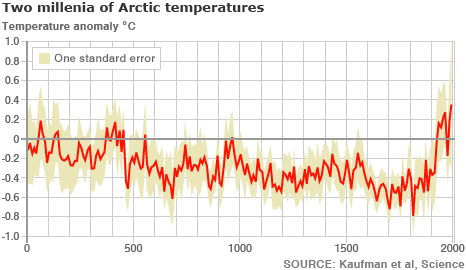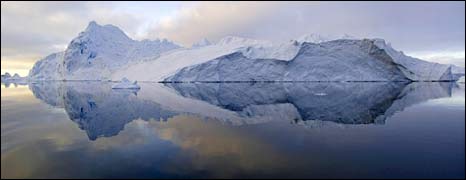Thursday, 3 September 2009,
By Richard Black, Environment correspondent, BBC News website
Arctic temperatures are now warmer than at any time in the last 2,000 years, research reveals.

Changes to the Earth’s orbit drove centuries of cooling, but temperatures rose fast in the last 100 years as human greenhouse gas emissions rose.
The result is a “hockey stick”-like sudden 90 degree turn, in which the last decade – 1998-2008 – stands out as the warmest in the entire series.
“The most pervasive signal in the reconstruction, the most prominent trend, is the overall cooling that took place for the first 1,900 years [of the 2000 yr record],” said study leader Darrell Kaufman from Northern Arizona University in Flagstaff, US.
“The 20th Century stands out in strong contrast to the cooling that should have continued. The last half-century was the warmest of the 2,000-year temperature record, and the last 10 years have been especially dramatic,” he told BBC News.
On average, the region cooled at a rate of 0.2C per millennium until about 1900. Since then, it has warmed by about 1.2C.

Scientists took evidence from ice cores, tree rings and lake sediments.
Writing in the journal Science, this confirms that the Arctic is very sensitive both to changes in solar heating and to greenhouse warming.
The 23 sites sampled were good enough to provide a decade-by-decade picture of temperatures across the region.
Much debate on climate change has centred on the Mediaeval Warm Period, or Mediaeval Climate Anomaly – a period about 1,000 years ago when, historical records suggest, Vikings colonised Greenland and may have grown grapes in Newfoundland.
The new analysis shows that temperatures were indeed warmer in this region 1,000 years ago than they were 100 years ago – but not as warm as they are now, or 1,000 years previously.
“It shows that the Mediaeval Warm Period is real, and is… an exception from the general trend of cooling,” commented Eystein Jansen from Bergen University in Norway, who was not involved in the research.
“It also shows there’s lots of variability on the 100-year timescale, and that’s probably more so in the Arctic than elsewhere.”
Professor Jansen was a co-ordinating lead author on the palaeoclimate (ancient climate) chapter of the last Intergovernmental Panel on Climate Change (IPCC) assessment.
Arctic wobbles
The root cause of the slow cooling was the orbital “wobble” that slowly varies, over thousands of years, the month in which the Earth approaches closest to the Sun.
This wobble slowly decreased the total amount of solar energy arriving in the Arctic region in summertime, and the temperature responded – until greenhouse warming took over.
“The 20th Century is the first century for which how much energy we’re getting from the Sun is no longer the most important thing governing the temperature of the Arctic,” said another of the study team, Nicholas McKay from the University of Arizona.
The recent warming of the Arctic has manifested itself most clearly in the drastic shrinkage in summer sea-ice extent, with the smallest area in the satellite era documented in 2007.
As the Science study emerged, UN Secretary-General Ban Ki-moon was telling the World Climate Conference in Geneva that many of the “more distant scenarios” forecast by climate scientists were “happening now”.
Earlier this week, Mr Ban visited the Arctic in an attempt to gain first-hand experience of how the region is changing.
“Scientists have been accused for years of scaremongering. But the real scaremongers are those who say we cannot afford climate action,” he said in his Geneva speech, calling for world leaders to make bigger pledges of action in the run-up to December’s UN climate summit in Copenhagen.





